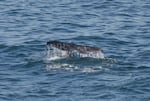
In this undated photo, a whale's tail breaches the surface of the Pacific Oregon off the Oregon Coast.
Courtesy Oregon Parks and Recreation Department
Spring Whale Watch Week kicks off Saturday along the Oregon Coast. While the weather won’t be ideal, there may be more gray whales migrating north to Alaska.
National Oceanic and Atmospheric Administration fisheries has announced the end of an unusual mortality event that affected the whales for about four years. NOAA spokesperson Michael Milstein told KLCC that, in recent years, they’ve counted more whales with calves migrating north.
“That suggests that the population has started to turn the corner,” he said, “And we’re really hopeful that this year as the whales migrate north and people get out to the coast to watch them that they’ll see more whales and hopefully more calves as well.”
During spring whale watch week, Oregon State Parks volunteers are stationed at 15 sites along the coast to help visitors spot whales and their calves as they travel north.
Last year, an estimated 14,500 gray whales were counted heading north off the West Coast. The latest numbers from NOAA show an increase to about 19,260. That’s about a 33% increase, Milstein told KLCC. Gray whales migrate about 10,000 miles each year round-trip between their home in Alaska and their spawning grounds off Mexico.
Spring Whale Watch Week is three days longer than last year and runs March 23 through 31.
While there are plenty of spots along the Oregon Coast where whales can typically be spotted, one option that includes exhibits and state park rangers is the Whale Watching Center in Depoe Bay. The location is run by the Oregon State Parks and Recreation Department and will be open 10 a.m. to 3 p.m. each day during Spring Whale Watch Week.
Parks officials ask visitors to observe beach safety guidelines and remain out of fenced areas.